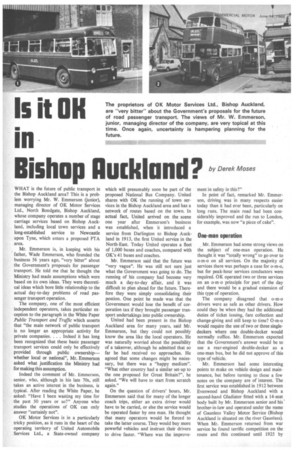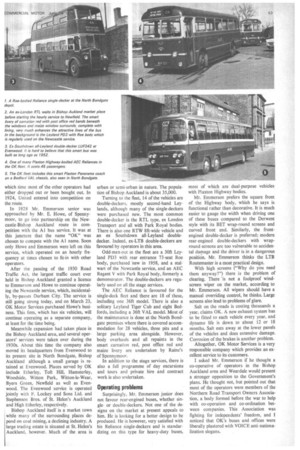Is it OK
Page 54

Page 55

If you've noticed an error in this article please click here to report it so we can fix it.
Bishop Auckland? by Derek Moses
WHAT is the future of public transport in the Bishop Auckland area? This is a problem worrying Mr. W. Emmerson (junior), managing director of OK Motor Services Ltd., North Bondgate, Bishop Auckland, whose company operates a number of stage carriage services based on Bishop Auckland, including local town services and a long-established service to Newcastle upon Tyne, which enters a proposed PTA area.
Mr. Emmerson is, in keeping with his father, Wade Emmerson, who founded the business 56 years ago, "very bitter" about the Government's proposals for passenger transport. He told me that he thought the Ministry had made assumptions which were based on its own ideas. They were theoretical ideas which bore little relationship to the actual day-to-day problems of road passenger transport operation.
The company, one of the most efficient independent operators, takes particular exception to the paragraph in the White Paper Public Transport and Traffic which asserts that "the main network of public transport is no longer an appropriate activity for private companies. . . Indeed it has long been recognized that these basic passenger transport services could only be effectively provided through public ownership— whether local or national", Mr. Emmerson asked what justification the Ministry had for making this assumption.
Indeed the comment of Mr. Emmerson, senior, who, although in his late 70s, still takes an active interest in the business, is typical. After reading the White Paper, he asked: "Have I been wasting my time for the past 50 years or so?" Anyone who studies the operations of OK can only answer "certainly not".
OK Motor Services is in a particularly tricky position, as it runs in the heart of the operating territory of United Automobile. Services Ltd„ a State-owned company which will presumably soon be part of the proposed National Bus Company. United shares with OK the running of town services in the Bishop Auckland area and has a network of routes based on the town. In actual fact, United arrived on the scene one year after Emmerson's business was established, when it introduced a service from Darlington to Bishop Auckland in 1913, the first United service in the North-East. Today United operates a fleet of 1,000 buses and coaches, compared with OK's 41 buses and coaches.
Mr. Emmerson said that the future was "very vague". He was still not sure just what the Government was going to do. The running of his company had become very much a day-to-day affair, and it was difficult to plan ahead for the future. Therefore they were simply consolidating their postion. One point he made was that the Government would lose the benefit of corporation tax if they brought passenger transport undertakings into public ownership.
United had been present in the Bishop Auckland area for many years, said Mr. Emmerson, but they could not possibly know the area like the local operators. He was naturally worried about the possibility of a takeover, although he admitted that so far he had received no approaches. He agreed that some changes might be necessary, but there was a "happy medium". "What other country had a similar set-up to the one proposed for Great Britain?", he asked. "We will have to start from scratch again."
On the question of drivers' hours, Mr. Emmerson said that for many of the longer coach trips, either an extra driver would have to be carried, or else the service would be operated faster by one man. He thought that many operators would be forced to take the latter course. They would buy more powerful vehicles and instruct their drivers to drive faster. "Where was the improve
ment in safety in this?"
In point of fact, remarked Mr. Emmerson, driving was in many respects easier today than it had ever been, particularly on long runs. The main road had been considerably improved and the run to London, for example, was now "a piece of cake".
One-man operation Mr. Emmerson had some strong views on the subject of one-man operation. He thought it was "totally wrong" to go over to o-m-o on all services. On the majority of services there was perhaps a case for o-m-o, but for peak-hour services conductors were required. OK operated two or three services on an o-m-o principle for part of the day and there would be a gradual extension of this type of operation.
The company disagreed that o-m-o drivers were as safe as other drivers. How could they be when they had the additional duties of ticket issuing, fare collection and change-giving and still keep to time? 0-m-o would require the use of two or three singledeckers where one double-decker would normally suffice. Mr. Emmerson expected that the Government's answer would be to use a rear-engined double-decker as a one-man bus, but he did not approve of this type of vehicle.
Mr. Emmerson had some interesting points to make on vehicle design and maintenance, but before turning to these a few notes on the company are of interest. The first service was established in 1912 between Evenwood and Bishop Auckland with a second-hand Gladiator fitted with a 14-seat body built by Mr. Emmerson senior and his • brother-in-law and operated under the name of Gaunless Valley Motor Service (Bishop Auckland is situated on the river Gaunless). When Mr. Emmerson returned from war service he found terrific competition on the route and this continued until 1925 by which time most of the other operators had either dropped out or been bought out. In 1924, United entered into competition on the route.
In 1928 Mr. Emmerson senior was approached by Mr. E. Howe, of Spennymoor, to go into partnership on the Newcastle-Bishop Auckland route in competition with the Al bus service. It was at this juncture that the name "OK" was chosen to compete with the Al name. Soon only Howe and Emmerson were left on this service, which operated on an hourly frequency at times chosen to fit-in with other operators.
After the passing of the 1930 Road Traffic Act, the largest traffic court ever held in Bishop Auckland granted a licence to Emmerson and Howe to continue operating the Newcastle service, which, incidentally, by-passes Durham City. The service is still going strong today, and on March 23, OK Motor Services purchased Howe's business. This firm, which has six vehicles, will continue operating as a separate company, at least for the time being.
Meanwhile expansion had taken place in the Bishop Auckland area, and several operators' services were taken over during the 1930s. About this time the company also moved its headquarters from Evenwood to its present site in North Bondgate, Bishop Auckland although a small garage is retained at Evenwood. Places served by OK include Etherley, Toft Hifi, Hamsterley, Woodside, Witton Park, Witton-le-Wear, Byers Green, Newfield as well as Evenwood. The Evenwood service is operated jointly with F, Lockey and Sons Ltd. • and Stephenson Bros. of St. Helen's Auckland and High Etherley, respectively.
Bishop Auckland itself is a market town while many of the surrounding places depend on coal mining, a declining industry. A large trading estate is situated at St. Helen's Auckland, however. Much of the area is urban or semi-urban in nature. The population of Bishop Auckland is about 35,000.
Turning to the fleet, 14 of the vehicles are double-deckers, mostly second-hand Leylands, although many of the single-deckers were purchased new. The most common double-decker is the RTL type, ex London Transport and all with Park Royal bodies. There is also one RTW 8ft-wide vehicle and an ex Southdown all-Leyland doubledecker. Indeed, ex-LTB double-deckers are favoured by operators in this area.
Odd-men-out in the fleet are a 30ft Leyland PD3 with rear entrance 73-seat Roe body, purchased 'new in 1958, and a stalwart of the Newcastle service, and an AEC Regent V with Park Royal body, formerly a demonstrator. The double-deckers are regularly used on all the stage services.
The AEC Reliance is favoured for the single-deck fleet and there are 18 of these, including one 36ft model. There is also a solitary Leyland Tiger Cub and eight Bedfords, including a 36ft VAL model. Most of the maintenance is done at the North Bondgate premises where there is covered accommodation for 28 vehicles, three pits and a large parking area alongside. However, body overhauls and all repaints in the smart carnation red, post office red and maize livery are undertaken by Raine's of Spennymoor.
In addition to the stage services, there is also a full programme of day excursions and tours and private hire and contract work is also undertaken.
Operating problems Surprisingly, Mr. Emmerson junior does not favour rear-engined buses, whether singleor double-deckers. Not one of the designs on the market at present appeals to him. He is looking for a better design to be produced. He is however, very satisfied with his Reliance single-deckers and is standardizing on this type for heavy-duty buses,
most of which are dual-purpose vehicles with Plaxton Highway bodies.
Mr. Emmerson prefers the square front of the Highway body, which he says is functional rather than decorative. It is much easier to gauge the width when driving one of these buses compared to the Derwent style with its BET wrap-round screens and curved front end. Similarly, the frontengined double-decker is preferred; modern rear-engined double-deckers with wrapround screens are too vulnerable to accidental damage and the driver is in a dangerous position. Mr. Emmerson thinks the LTB Routemaster is a most practical design.
With high screens ("Why do you need them anyway?") there is the problem of clearing. There 'is not a foolproof windscreen wiper on the market, according to Mr. Emmerson. All wipers should have a manual overriding control, he thinks. Large screens also lead to problems of glare.
Salt on the roads is costing thousands a year, claims OK. A new exhaust system has to be fitted to each vehicle every year, and dynamo life is down to about 12 or 18 months. Salt eats away at the lower panels of the vehicles and does extensive damage. Corrosion of the brakes is another problem.
Altogether, OK Motor Services is a very responsible company which provides an excellent service to its customers.
I asked Mr. Emmerson if he thought a co-operative of operators in the Bishop Auckland area and Weardale would present a stronger opposition to the Government's plans. He thought not, but pointed out that most of the operators were members of the Northern Road Transport Owners Association, a body formed before the war to help with co-operation and co-ordination between companies. This Association was fighting for independents' freedom, and I noticed that OK's buses and offices were liberally plastered with VOICE anti-nationalization slogans.




























































































































